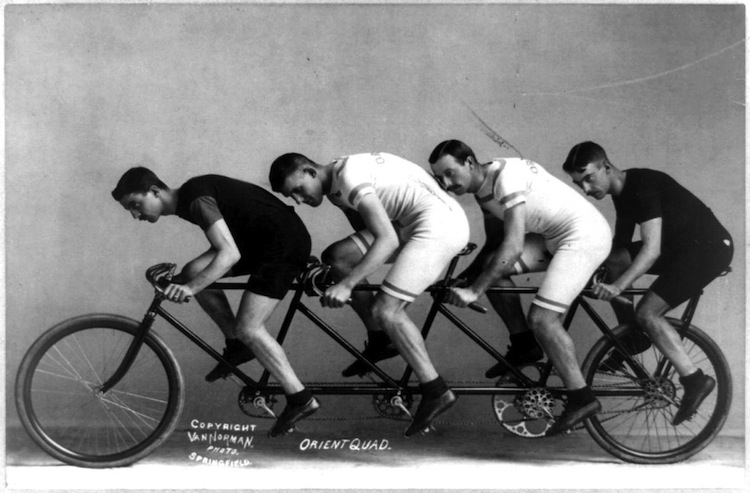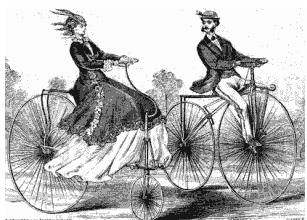Tandem bicycles are specially built for two riders and include two seats, two sets of pedals and two handlebars. The more experienced tandem cyclist or the one with the greatest upper body strength, is best suited to ride in the front seat. They are responsible for controlling the bike’s direction and speed while warning the back seat rider of upcoming obstacles, bumps, and gear shifts.
The rear rider is mainly a source of extra cruising power for the bike. They must be very careful to keep their weight centrally balanced while cruising and lean to one side only on turns. If not well-balanced they could tip the entire tandem bicycle over.
When did the tandem first appear?
Patents related to tandem bicycles date from the late 1800s.
The two-wheeled “safety bicycle” configuration that we recognize today as a tandem seems to show up in the early 1890’s and there is reference to one being issue a patent in 1895. Many of the early tandems were “courting bikes” designed for a man and woman which placed the lady in the front seat with the man behind and steering the bike through a linkage from the rear position.
One of the more famous variants was produced by Ignaz Schwinn who included a special “middle seat” for his young son.
These frames were a common sight well into the 1900’s. There were of course racing tandems designed for men and tandems becamet triplets, quads, quints and even a ten-seat monster from the Orient Bicycle Company. The quintuplets were often used to pace track racers up to higher speeds prior to the invention of the motorcycle whereas machines like the 1896 Orient Orietin were basically promotional bikes.
Possibly Tandems were created because it’s the best way to share a bicycle ride with someone you want to be close to or with someone who wouldn’t otherwise be able to enjoying cycling on their own.
Modern technology has improved component and frame designs and many tandems are as well-built as modern high-end road and off-road bikes. As they are driven by two people they can often reach good speeds.
While you might not see the tandem bicycle out as much as you see traditional bikes, these items have significant historical value. Tandem bikes first became popular because of their use in courting rituals, as interested suitors could take ladies out for a bike ride, without the woman having to exert herself physically. Today, riders use tandem bicycles because they allow riders to reach high speeds that one person simply cannot reach alone, although they can create problems for riders because of their size.
Original Tandems
Designed by the Rucker Company in 1884, the first tandem bicycles joined two high wheels containing forks together with a jointed backbone. Because these bikes did not have one smaller wheel, they remained extremely stable, as long as the riders worked together when steering and balancing. Rucker later introduced a tandem bicycle with a smaller front wheel. This made steering easier because it put the rear rider solely in charge, but it also compromised the bike’s stability.
Next Generation
As inventors gained more knowledge on this subject, Hillman, Herbert and Cooper created a chain-driven tandem bike in 1887 that saw both riders pedaling the front wheel, while using both wheels to steer. The first renditions of the tandem bikes used together appear shortly thereafter, as the Invincible Tandem Safety and the Ivel Tandem Safety placed both riders between the two wheels, with both of them pedaling on the back wheel.
Tandems for Courtship
Further tandem bicycles saw special designs created for couples. Humber and Company Ltd. built an open-fronted tandem bike that gave the lady enough room to have her dress hang free if sitting at the front of the bike, while providing her with a virtually vibration free ride because of her position between the two wheels. This design also gave the female a chance to escape the bike if an accident occurred, so she became less likely to injure herself. The design gave the man, or rear rider, full control over the steering.
Today’s Tandems
While you likely will not see many tandems on the road today, many people do enjoy them because they allow riders to reach extremely high speeds. The issue remains that they can create difficulties when you attempt to travel with and store them because of their size. The parts also differ from those found on traditional bicycles, so you might have difficulty finding parts if the bike runs into problems.
References
- “Bicycles and Tricycles”; Archibald Sharp; 1896
- “Modern Cycles: A Practical Handbook”; A.J. Wallis-Tayler; 1897
- “Bicycle Technology: Understanding the Modern Bicycle and its Components”; Rob van der Plas, et al.; 2010
Credit: http://www.livestrong.com/









